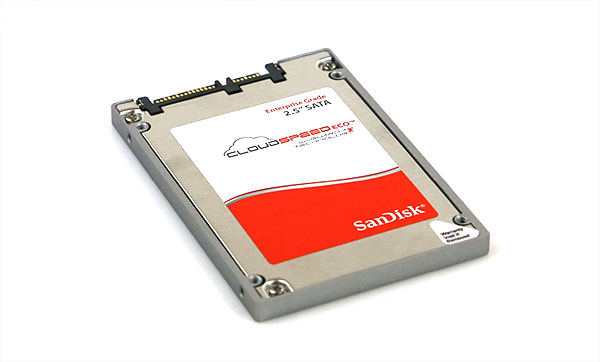The SanDisk CloudSpeed Eco is the company’s lower-cost SSD for read heavy applications. While the press does put a heavy emphasis on write endurance, there are many workloads that require the low latency of a SSD but are more of write once (or a few times) but read often workloads. The SanDisk CloudSpeed Eco 960GB drive features a 1 DWPD rating, but only over 3 years. Many of the SSDs we have been testing use a 5 year figure. On the spec sheet, while the other members of the CloudSpeed line carry eMLC nand, the Eco uses cMLC. Interestingly enough, the net impact is a fast drive. As we release the quick benchmarks for some of the other drives, the Eco 960GB drive is actually one of the faster performers. It pushes the SATA III interface harder than many of its peers.
Test Configuration
Since we are going to assume the use of already released hardware, we are using a legacy system for testing across the test suite:
- Motherboard: Gigabyte GA-7PESH3
- Processors: Dual Intel Xeon E5-2690 (V2)
- SAS Controller: LSI SAS 3008
- RAM: 64GB DDR3L-1600MHz ECC RDIMMs
- OS SSD: Kingston V300 240GB
We are using a SAS controller so one cannot compare results directly to consumer-driven setups where a SATA SSD is connected to an Intel PCH port. There is a latency penalty for going over the PCIe bus to a controller to SAS. It also is a reason NVMe is going to be a game changer in the enterprise storage space.
SanDisk CloudSpeed Eco 960GB SSD Quick Benchmarks
For our quick tests during this part of the series we will just provide the quick benchmarks with only a bit of commentary. The results should be fairly straightforward and we have added a few results for comparison purposes.
AS SSD Benchmark
AS SSD is a solid benchmark that does not write compressible data to drives. The result is perhaps one of the best workstation SSD benchmarks available today.

Here we can see that the SanDisk CloudSpeed Eco performs fairly well. It actually out-performs the CloudSpeed 1000E and Optimus Ascend in many of our tests.
CrystalDiskMark
CrystalDiskMark is another benchmark which gives non-compressible read/write numbers. This is in contrast to the ATTO Benchmark used by LSI/ Sandforce and its partners when they market a given solid state drive.

Our CrystalDiskMark results highlight how competitive the market is. We can see the CloudSpeed Eco 960GB drive perform well against many competitors on both the SATA and SAS sides. Particularly interesting is that it outperforms the Samsung SV843 in a number of tests.
ATTO Benchmark
The value of the ATTO benchmark is really to show the best-case scenario. ATTO is known to write highly compressible data to drives, which inflates speeds of controllers that compress data like LSI/ SandForce does prior to writing on a given solid state drive.

On the read performance side, we can see that the SanDisk CloudSpeed Eco 960GB tracks well to the 1000E we looked at previously. The drives are not the fastest but this is a very tough competitive roundup.

On the write side we see the CloudSpeed Eco 960GB exhibit a similar behavior to the other SanDisk and Intel drives in the comparisons with the very small (2k and below) transfer sizes lagging but then getting competitive again at 4k. Write performance is decidedly in the middle of our datacenter SSD comparison group.
Conclusion
We managed to get our SanDisk CloudSpeed Eco 960GB SSDs at a relative bargain. We have some of these drives headed to the STH colocation facility as the two dozen or so SanDisk CloudSpeed drives have been very stable for us. WordPress is a great example of a write once but read many times application, and it is an extremely popular web application. After over 5.5 years of reviews, how to guides and benchmarks, the bulk of STH’s storage needs are for images which are larger sequential transfers. It is this type of market that SanDisk is targeting with this drive. We will be publishing results for the current SanDisk CloudSpeed line in the near future as testing is already complete.




